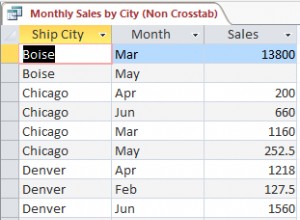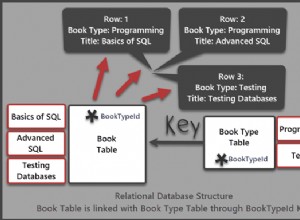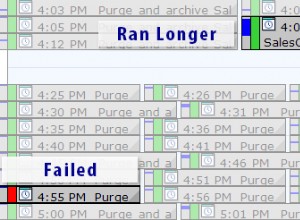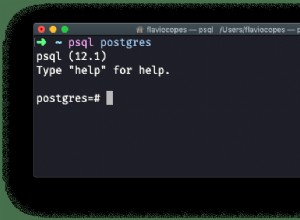Este código es bastante largo. Me disculpo. Consta de dos procedimientos almacenados. Puede estar satisfecho ejecutando solo el primero. El segundo usa la salida del primero (los datos que el primero dejó en las tablas). También puede combinar el código en uno. Pero los mantuve separados. El segundo proceso almacenado produce la salida para parecerse a describe myTable . Pero lo realiza para TODOS tablas en la base de datos que desee tal resultado.
Se usa pasando un parámetro (cadena) para que la base de datos informe.
Creo una base de datos separada y el código hace referencia explícita a las tablas de esa base de datos por su nombre. Entonces, si tiene EXECUTE privilegios para este procedimiento almacenado, puede ejecutarlo desde cualquier base de datos actual. Entonces, como prueba simple, no configure la base de datos de informes como su base de datos actual, y simplemente llame al procedimiento almacenado por su nombre (calificado con el nombre de la base de datos de informes). Todo esto se muestra en el fragmento de prueba a continuación.
Dos procedimientos almacenados
CREATE SCHEMA Reporting101a; -- See **Note1**
DROP PROCEDURE IF EXISTS `Reporting101a`.`describeTables_v2a`;
DELIMITER $$
CREATE DEFINER=`root`@`localhost` PROCEDURE `Reporting101a`.`describeTables_v2a`(
IN dbName varchar(100), -- the dbname to report table structures
OUT theSession int, -- OUT parameter for session# assigned
IN deleteSessionRows BOOL, -- true for delete rows when done from main reporting table for this session#
IN callTheSecondStoredProc BOOL -- TRUE = output is from Pretty output in Second Stored Proc. FALSE= not so pretty output
)
BEGIN
DECLARE thisTable CHAR(100);
DROP TEMPORARY TABLE IF EXISTS Reporting101a.tOutput;
CREATE TEMPORARY TABLE Reporting101a.tOutput
( id int auto_increment primary key,
tblName varchar(100) not null,
ordVal int not null,
cField varchar(100) not null,
cType varchar(100) not null,
cNull varchar(100) not null,
cKey varchar(100) not null,
cDefault varchar(100) null,
cExtra varchar(100) null
);
DROP TEMPORARY TABLE IF EXISTS Reporting101a.tOutput2;
CREATE TEMPORARY TABLE Reporting101a.tOutput2
( tblName varchar(100) primary key,
colCount int not null,
cFieldMaxLen int not null,
cTypeMaxLen int not null,
cNullMaxLen int not null,
cKeyMaxLen int not null,
cDefaultMaxLen int not null,
cExtraMaxLen int not null
);
INSERT Reporting101a.tOutput(tblName,ordVal,cField,cType,cNull,cKey,cDefault,cExtra)
SELECT TABLE_NAME,ORDINAL_POSITION,COLUMN_NAME AS Field, COLUMN_TYPE AS TYPE, RPAD(IS_NULLABLE,4,' ') AS 'Null',
RPAD(COLUMN_KEY,3,' ') AS 'Key',RPAD(COLUMN_DEFAULT,7,' ') AS 'DEFAULT',EXTRA AS Extra
FROM information_schema.columns WHERE table_schema = dbName ORDER BY table_name,ordinal_position;
-- select * from information_schema.columns WHERE table_schema = '57security' order by table_name,ordinal_position;
UPDATE Reporting101a.tOutput
SET cExtra=' '
WHERE cExtra='';
UPDATE Reporting101a.tOutput
SET cField=RPAD(cField,5,' ')
WHERE LENGTH(cField)<5;
INSERT Reporting101a.tOutput2(tblName,colCount,cFieldMaxLen,cTypeMaxLen,cNullMaxLen,cKeyMaxLen,cDefaultMaxLen,cExtraMaxLen)
SELECT tblName,COUNT(*),0,0,0,0,0,0
FROM Reporting101a.tOutput
GROUP BY tblName;
UPDATE tOutput2 t2
JOIN
( SELECT tblName,MAX(LENGTH(cField)) AS mField,MAX(LENGTH(cType)) AS mType,MAX(LENGTH(cNull)) AS mNull,
IFNULL(MAX(LENGTH(cKey)),0) AS mKey,IFNULL(MAX(LENGTH(cDefault)),0) AS mDefault,IFNULL(MAX(LENGTH(cExtra)),0) AS mExtra
FROM Reporting101a.tOutput
GROUP BY tblName
) x
ON x.tblName=t2.tblName
SET t2.cFieldMaxLen=x.mField,t2.cTypeMaxLen=x.mType,cNullMaxLen=x.mNull,
cKeyMaxLen=x.mKey,cDefaultMaxLen=x.mDefault,cExtraMaxLen=x.mExtra;
-- DROP TABLE Reporting101a.reportDataDefsSession; -- useful for quick change of structure of table
-- note, keep above drop call remmed out ! Just use it for quick tweaks to structure
CREATE TABLE IF NOT EXISTS Reporting101a.reportDataDefsSession
( -- for the sole purpose of safe session auto_inc usage
-- Please don't delete unless you want the sessions to experience aberant behavior
sessionId INT AUTO_INCREMENT PRIMARY KEY,
dummy CHAR(1) NOT NULL,
creationDT datetime not null
);
CREATE TABLE IF NOT EXISTS Reporting101a.reportDataDefs
( sessionId INT NOT NULL,
tblName VARCHAR(100) NOT NULL, -- Tablename
ordVal INT NOT NULL, -- the "position number" of the Column
cField VARCHAR(100) NOT NULL, -- The Column
cType VARCHAR(100) NOT NULL, -- Datatype
cNull VARCHAR(100) NOT NULL, -- Nullability
cKey VARCHAR(100) NOT NULL, -- Key info
cDefault VARCHAR(100) NULL, -- Default value
cExtra VARCHAR(100) NULL, -- Extra output
colCount INT NOT NULL, -- the columns here and below are de-normalize data
cFieldMaxLen INT NOT NULL,
cTypeMaxLen INT NOT NULL,
cNullMaxLen INT NOT NULL,
cKeyMaxLen INT NOT NULL,
cDefaultMaxLen INT NOT NULL,
cExtraMaxLen INT NOT NULL
);
-- For lack of a better notion, we are calling calls "sessions". The programmer calls the
-- First Stored Proc, and we call that a session after we get a unique next incrementing number.
-- That number is the session #. House all output with that as a column value. This allows us to
-- move between stored procs, have safe output, have historical snapshots, and retain the data
-- via a session # for later use, whatever use.
INSERT Reporting101a.reportDataDefsSession(dummy,creationDT) VALUES ('X',now());
SET @mySession=LAST_INSERT_ID(); -- there it is, our session # (read the above paragraph)
INSERT Reporting101a.reportDataDefs(sessionId,tblName,ordVal,cField,cType,cNull,cKey,cDefault,cExtra,
colCount,cFieldMaxLen,cTypeMaxLen,cNullMaxLen,cKeyMaxLen,cDefaultMaxLen,cExtraMaxLen)
SELECT @mySession,t1.tblName,t1.ordVal,t1.cField,t1.cType,t1.cNull,t1.cKey,t1.cDefault,t1.cExtra,
t2.colCount,t2.cFieldMaxLen,t2.cTypeMaxLen,t2.cNullMaxLen,t2.cKeyMaxLen,t2.cDefaultMaxLen,t2.cExtraMaxLen
FROM Reporting101a.tOutput t1
JOIN Reporting101a.tOutput2 t2
ON t2.tblName=t1.tblName
ORDER BY t1.tblName,t1.id;
DROP TEMPORARY TABLE Reporting101a.tOutput;
DROP TEMPORARY TABLE Reporting101a.tOutput2;
SET [email protected]; -- the OUT var that came in as a parameter
-- ***************************************************************************
-- ***************************************************************************
-- Label "Some_Sort_of_Output":
IF callTheSecondStoredProc=TRUE THEN
-- The caller says to call the second stored proc (for Pretty Printing)
-- This will generate output similar to `DESCRIBE myTable`
-- But remember, it will do it for EVERY table in referenced database
CALL Reporting101a.`Print_Tables_Like_Describe`(@mySession);
-- The above call just gave you output.
ELSE
-- The caller chose to not auto call the Pretty Printing second stored procedure.
-- Note, the caller can easily call it right after using the OUT parameter.
-- So our output will be a resultset of out reportDataDefs table for this session #
SELECT *
FROM Reporting101a.reportDataDefs
WHERE [email protected]
ORDER BY tblName,ordVal;
END IF;
-- ***************************************************************************
-- ***************************************************************************
IF deleteSessionRows=TRUE THEN
-- The caller says output rows are NOT needed at this point. Delete them.
-- Note, if this boolean comes in TRUE, you can't call Pretty Printing
-- second stored procedure with the session # because the data is gone.
--
-- Regardless, you are getting something back from "Some_Sort_of_Output" above.
DELETE FROM Reporting101a.reportDataDefs
WHERE [email protected];
END IF;
END$$
DELIMITER ;
DROP PROCEDURE IF EXISTS `Reporting101a`.`Print_Tables_Like_Describe`;
DELIMITER $$
CREATE DEFINER=`root`@`localhost` PROCEDURE `Reporting101a`.`Print_Tables_Like_Describe`(
pSessionId INT
)
BEGIN
DECLARE done INT DEFAULT FALSE;
DECLARE curTable VARCHAR(100) DEFAULT '';
DECLARE bFirst BOOL DEFAULT TRUE;
DECLARE lv_tblName,lv_cField,lv_cType,lv_cNull,lv_cKey,lv_cDefault,lv_cExtra VARCHAR(100);
DECLARE lv_ordVal,lv_colCount,lv_cFieldMaxLen,lv_cTypeMaxLen,lv_cNullMaxLen,lv_cKeyMaxLen,lv_cDefaultMaxLen,lv_cExtraMaxLen INT;
DECLARE cur1 CURSOR FOR SELECT tblName,ordVal,cField,cType,cNull,cKey,cDefault,cExtra,
colCount,cFieldMaxLen,cTypeMaxLen,cNullMaxLen,cKeyMaxLen,cDefaultMaxLen,cExtraMaxLen
FROM Reporting101a.reportDataDefs
WHERE sessionId=pSessionId
ORDER BY tblName,ordVal;
DECLARE CONTINUE HANDLER FOR NOT FOUND SET done = TRUE;
-- Please note in the above, CURSOR stuff must come last else "Error 1337: Variable or condition decl aft curs"
CREATE TABLE IF NOT EXISTS Reporting101a.reportOutput
( lineNum INT AUTO_INCREMENT PRIMARY KEY,
sessionId INT NOT NULL,
lineOut varchar(100) NOT NULL
);
-- INSERT Reporting101a.reportOutput(sessionId,lineOut)
-- SELECT
-- SET curTable='';
DELETE FROM Reporting101a.reportOutput
WHERE sessionId=pSessionId;
OPEN cur1;
read_loop: LOOP
FETCH cur1 INTO lv_tblName,lv_ordVal,lv_cField,lv_cType,lv_cNull,lv_cKey,lv_cDefault,lv_cExtra,
lv_colCount,lv_cFieldMaxLen,lv_cTypeMaxLen,lv_cNullMaxLen,lv_cKeyMaxLen,lv_cDefaultMaxLen,lv_cExtraMaxLen ;
IF done THEN
LEAVE read_loop;
END IF;
IF lv_tblName<>curTable THEN
IF bFirst=FALSE THEN
INSERT Reporting101a.reportOutput(sessionId,lineOut)
SELECT pSessionId,'';
ELSE
SET bFirst=FALSE;
END IF;
INSERT Reporting101a.reportOutput(sessionId,lineOut)
SELECT pSessionId,lv_tblName;
INSERT Reporting101a.reportOutput(sessionId,lineOut)
SELECT pSessionId,CONCAT('+-',
REPEAT('-',GREATEST(5,lv_cFieldMaxLen)), '-+-',
REPEAT('-',GREATEST(4,lv_cTypeMaxLen)), '-+-',
REPEAT('-',GREATEST(4,lv_cNullMaxLen)), '-+-',
REPEAT('-',GREATEST(3,lv_cKeyMaxLen)), '-+-',
REPEAT('-',GREATEST(7,lv_cDefaultMaxLen)), '-+-',
REPEAT('-',GREATEST(5,lv_cExtraMaxLen)), '-+');
SET @dashLineNumRow=LAST_INSERT_ID();
INSERT Reporting101a.reportOutput(sessionId,lineOut)
SELECT pSessionId,CONCAT('| ',
'Field',
REPEAT(' ',GREATEST(0,lv_cFieldMaxLen-5)), ' | ',
'Type',
REPEAT(' ',GREATEST(0,lv_cTypeMaxLen-4)), ' | ',
'Null',
REPEAT(' ',GREATEST(0,lv_cNullMaxLen-4)), ' | ',
'Key',
REPEAT(' ',GREATEST(0,lv_cKeyMaxLen-3)), ' | ',
'Default',
REPEAT(' ',GREATEST(0,lv_cDefaultMaxLen-7)), ' | ',
'Extra',
REPEAT(' ',GREATEST(0,lv_cExtraMaxLen-5)), ' |');
INSERT Reporting101a.reportOutput(sessionId,lineOut)
SELECT pSessionId,lineOut
FROM Reporting101a.reportOutput
WHERE [email protected];
-- SELECT * FROM Reporting101a.reportDataDefs WHERE sessionId=24;
SET curTable=lv_tblName;
END IF;
INSERT Reporting101a.reportOutput(sessionId,lineOut)
SELECT pSessionId,
CONCAT('| ',
COALESCE(lv_cField,''),
COALESCE(REPEAT(' ',GREATEST(0,lv_cFieldMaxLen-LENGTH(lv_cField))),''),' | ',
COALESCE(lv_cType,''),
COALESCE(REPEAT(' ',GREATEST(0,lv_cTypeMaxLen-LENGTH(lv_cType))),''),' | ',
COALESCE(lv_cNull,''),
COALESCE(REPEAT(' ',GREATEST(0,lv_cNullMaxLen-LENGTH(lv_cNull))),''),' | ',
COALESCE(lv_cKey,' '),
COALESCE(REPEAT(' ',GREATEST(0,lv_cKeyMaxLen-LENGTH(lv_cKey))),''),' | ',
COALESCE(lv_cDefault,' '),
COALESCE(REPEAT(' ',GREATEST(0,lv_cDefaultMaxLen-LENGTH(lv_cDefault))),''),' | ',
COALESCE(lv_cExtra,' '),
COALESCE(REPEAT(' ',GREATEST(0,lv_cExtraMaxLen-LENGTH(lv_cExtra))),''),' |');
INSERT Reporting101a.reportOutput(sessionId,lineOut)
SELECT pSessionId,lineOut
FROM Reporting101a.reportOutput
WHERE [email protected];
END LOOP;
CLOSE cur1;
select lineOut as '' from Reporting101a.reportOutput where sessionId=pSessionId order by lineNum;
END$$
DELIMITER ;
Prueba
Prueba:
-- See **Note2**
SET @theOutVar =-1; -- A variable used as the OUT variable below
-- See **Note3**
-- Note: with `TRUE` as the 4th parameter, this is a one call deal. Meaning, you are done.
call Reporting101a.describeTables_v2a('stackoverflow',@theOutVar,false,true);
-- See **Note4**
-- Primarily used if the 4th parameter above is false
call Reporting101a.Print_Tables_Like_Describe(@theOutVar); -- loads data for prettier results in chunk format.
Salida
+--------------------------------------------------------------------------------------------+
| |
+--------------------------------------------------------------------------------------------+
| course |
| +------------+--------------+------+-----+---------+----------------+ |
| | Field | Type | Null | Key | Default | Extra | |
| +------------+--------------+------+-----+---------+----------------+ |
| | courseId | int(11) | NO | PRI | | auto_increment | |
| +------------+--------------+------+-----+---------+----------------+ |
| | deptId | int(11) | NO | MUL | | | |
| +------------+--------------+------+-----+---------+----------------+ |
| | courseName | varchar(100) | NO | | | | |
| +------------+--------------+------+-----+---------+----------------+ |
| |
| dept |
| +----------+--------------+------+-----+---------+----------------+ |
| | Field | Type | Null | Key | Default | Extra | |
| +----------+--------------+------+-----+---------+----------------+ |
| | deptId | int(11) | NO | PRI | | auto_increment | |
| +----------+--------------+------+-----+---------+----------------+ |
| | deptName | varchar(100) | NO | | | | |
| +----------+--------------+------+-----+---------+----------------+ |
| |
| scjunction |
| +------------+---------+------+-----+---------+----------------+ |
| | Field | Type | Null | Key | Default | Extra | |
| +------------+---------+------+-----+---------+----------------+ |
| | id | int(11) | NO | PRI | | auto_increment | |
| +------------+---------+------+-----+---------+----------------+ |
| | studentId | int(11) | NO | MUL | | | |
| +------------+---------+------+-----+---------+----------------+ |
| | courseId | int(11) | NO | MUL | | | |
| +------------+---------+------+-----+---------+----------------+ |
| | term | int(11) | NO | | | | |
| +------------+---------+------+-----+---------+----------------+ |
| | attendance | int(11) | NO | | | | |
| +------------+---------+------+-----+---------+----------------+ |
| | grade | int(11) | NO | | | | |
| +------------+---------+------+-----+---------+----------------+ |
| |
| student |
| +-----------+--------------+------+-----+---------+----------------+ |
| | Field | Type | Null | Key | Default | Extra | |
| +-----------+--------------+------+-----+---------+----------------+ |
| | studentId | int(11) | NO | PRI | | auto_increment | |
| +-----------+--------------+------+-----+---------+----------------+ |
| | fullName | varchar(100) | NO | | | | |
| +-----------+--------------+------+-----+---------+----------------+ |
| |
| testtable |
| +-----------------------------------------+---------------+------+-----+---------+-------+ |
| | Field | Type | Null | Key | Default | Extra | |
| +-----------------------------------------+---------------+------+-----+---------+-------+ |
| | noPKhere | int(11) | NO | | | | |
| +-----------------------------------------+---------------+------+-----+---------+-------+ |
| | veryLongColumnName_And_Then.Some_%_More | decimal(12,2) | YES | | | | |
| +-----------------------------------------+---------------+------+-----+---------+-------+ |
| | limit | int(11) | NO | | | | |
| +-----------------------------------------+---------------+------+-----+---------+-------+ |
| |
| testtable2 |
| +-------+---------+------+-----+---------+-------+ |
| | Field | Type | Null | Key | Default | Extra | |
| +-------+---------+------+-----+---------+-------+ |
| | id | int(11) | NO | PRI | | | |
| +-------+---------+------+-----+---------+-------+ |
+--------------------------------------------------------------------------------------------+
Nota 1 :Una base de datos llamada Reporting101a se crea para albergar dos procedimientos almacenados y algunas tablas de soporte. Estas rutinas comienzan con una llamada a un procedimiento almacenado que se refiere a la base de datos sobre la que se informará mediante el uso de una cadena.
Se accede a los datos para producir la salida a través del INFORMATION_SCHEMA especial base de datos de una manera segura de sólo LECTURA. Como tal, la base de datos sobre la que se informa no se toca.
Hay tres tablas no temporales guardadas en esta base de datos.
reportDataDefsSession- Una tabla simple utilizada para obtener una sesión#reportDataDefs- retorno de datos deINFORMATION_SCHEMAy masajeó un poco. Está basado en sesiones.reportOutput- Una tabla para imprimir comoDESCRIBEde MySQL . Es solo una tabla para juntar la salida. Está basado en sesiones.
Nota 2 :Este INT la variable se incluye como OUT parámetro de destino, escrito en, y le permite encajar su otro código después de que el primer procedimiento almacenado prepare los datos. Representa un número de sesión que aísla la salida para informes posteriores.
Algunos entornos como PHP tienen ciertos trucos que hacen que esto sea un problema para algunos programadores. Entonces, si necesita combinar ambos procedimientos almacenados por su cuenta, hágalo (o pídame que lo haga por separado si está confundido).
En cualquier caso, muestra cómo los datos o los esfuerzos pueden encadenar llamadas a procedimientos almacenados.
Honestamente una de las principales razones por las que salgo con un número de sesión como parámetro de SALIDA es que sé que tengo que crear un CURSOR para obtener un resultado bonito. Y eso requiere un Cursor DECLARE
en la parte superior de un segundo procedimiento almacenado. Y DECLARE s debe aparecer en la parte superior de un procedimiento almacenado. Entonces, con las manos atadas, tomé esta ruta.
Nota 3 :Esta es la llamada al primer procedimiento almacenado. Es muy probable que termine después de que esta llamada tenga VERDADERO como su cuarto parámetro. El procedimiento almacenado está bastante bien documentado en su interior. El tercer parámetro es para si desea o no que se eliminen los datos de la tabla de informes para el número de sesión. La eliminación se produce después de cualquier salida como conjunto de resultados. Entonces, esto depende de tu elección.
Parámetros:
- el nombre de la base de datos para describir todas las tablas como
describe myTable - el
INTOUTparámetro para mantener la sesión # - booleano:desea que los datos se eliminen de la tabla de informes al final
- booleano:¿deberíamos llamar automáticamente al procedimiento almacenado de impresión bonita que genera
describe? -como salida. Si decide pasar el parámetro 4 comoFALSE, entonces su salida puede parecerse a esto:
Nota 4 :Se usa en los casos en los que desea una salida diferente pero desea que funcione la sesión #. Por lo general, no necesita esto.





